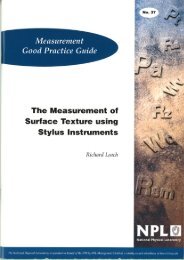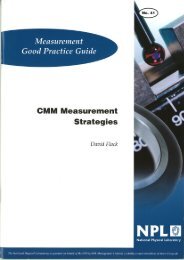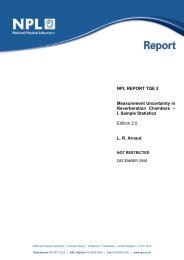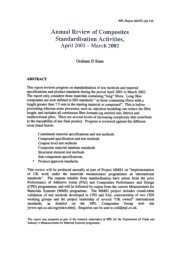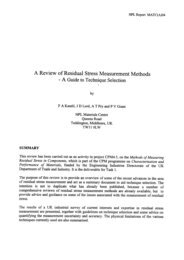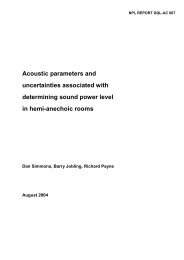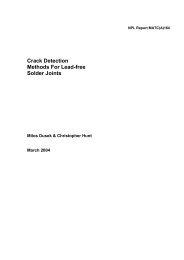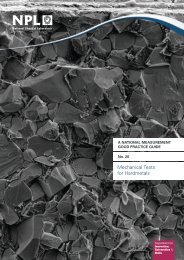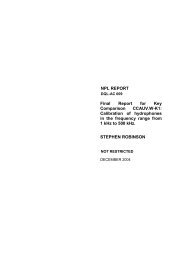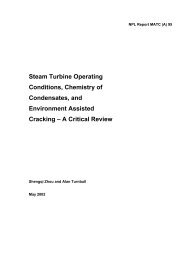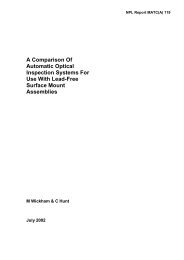Protocol for Establishing and Maintaining the Calibration - NPL ...
Protocol for Establishing and Maintaining the Calibration - NPL ...
Protocol for Establishing and Maintaining the Calibration - NPL ...
Create successful ePaper yourself
Turn your PDF publications into a flip-book with our unique Google optimized e-Paper software.
18 Good Practice Guide 93 Chapter 2<br />
<strong>for</strong> different linearity characteristics in each range, <strong>the</strong> individual ranges may also have separate<br />
gain adjustments. If <strong>the</strong>se are not properly matched, this will result in a step in <strong>the</strong> response as <strong>the</strong><br />
electrometer switches between adjacent ranges.<br />
The preceding three electronics effects are illustrated graphically in Figure 2.1.<br />
Figure 2.1<br />
Effects of inherent accuracy, linearity <strong>and</strong> range changing in electrometers<br />
10 6<br />
10 5<br />
measured response<br />
"ideal" response<br />
Indicated response<br />
10 4<br />
10 3<br />
10 2<br />
10 1<br />
inaccuracy<br />
{<br />
range change<br />
effect<br />
10 0 10 0 10 1 10 2 10 3 10 4 10 5 10 6<br />
non-linearity<br />
Expected response<br />
Generally, <strong>the</strong> supplier will quote a level of uncertainty, which encompasses each of <strong>the</strong>se three<br />
components <strong>and</strong> 1 to 2% uncertainty is common. However, <strong>the</strong> level of confidence is often not<br />
quoted <strong>and</strong> it is normally prudent to assume that <strong>the</strong> quoted uncertainty is at a 68% level of<br />
confidence, k = 1.<br />
2.4 Statistical<br />
Repeatability defines <strong>the</strong> precision with which a single measurement is made. Because of <strong>the</strong><br />
r<strong>and</strong>om nature of radioactive decay, within two separate but equal measurement periods, <strong>the</strong>re will<br />
be a difference between <strong>the</strong> number of events that occur as well as <strong>the</strong> number of interactions per<br />
event in <strong>the</strong> gas <strong>and</strong> <strong>the</strong> number of ion pairs produced. This will result in two different<br />
measurement results <strong>for</strong>, effectively, <strong>the</strong> same measurement (this of course assumes that <strong>the</strong>re is no<br />
significant decay between <strong>the</strong> two measurement periods). If a series of n sequential identical<br />
measurements (x i ) are made, it is possible to determine <strong>the</strong> uncertainty on a single measurement by<br />
calculating <strong>the</strong> mean <strong>and</strong> st<strong>and</strong>ard deviation of that series. The normal equations are used:<br />
mean, x =<br />
n<br />
∑<br />
i=<br />
1<br />
n<br />
x<br />
i<br />
st<strong>and</strong>ard deviation, s(x) =<br />
n<br />
∑ ( xi<br />
− x)<br />
i=<br />
1<br />
( n − 1)<br />
2<br />
(1)



